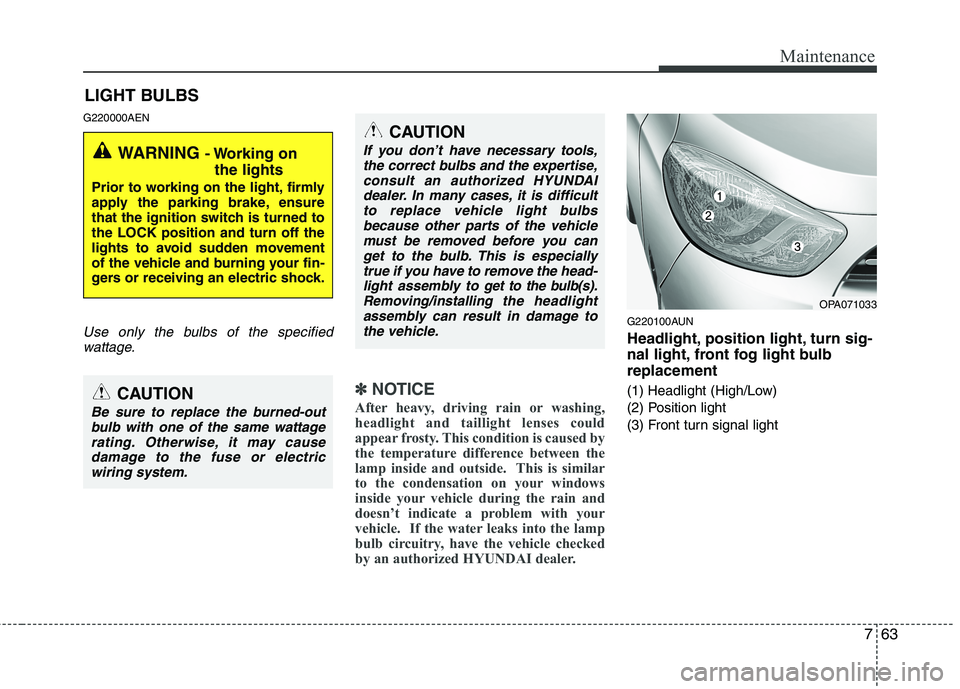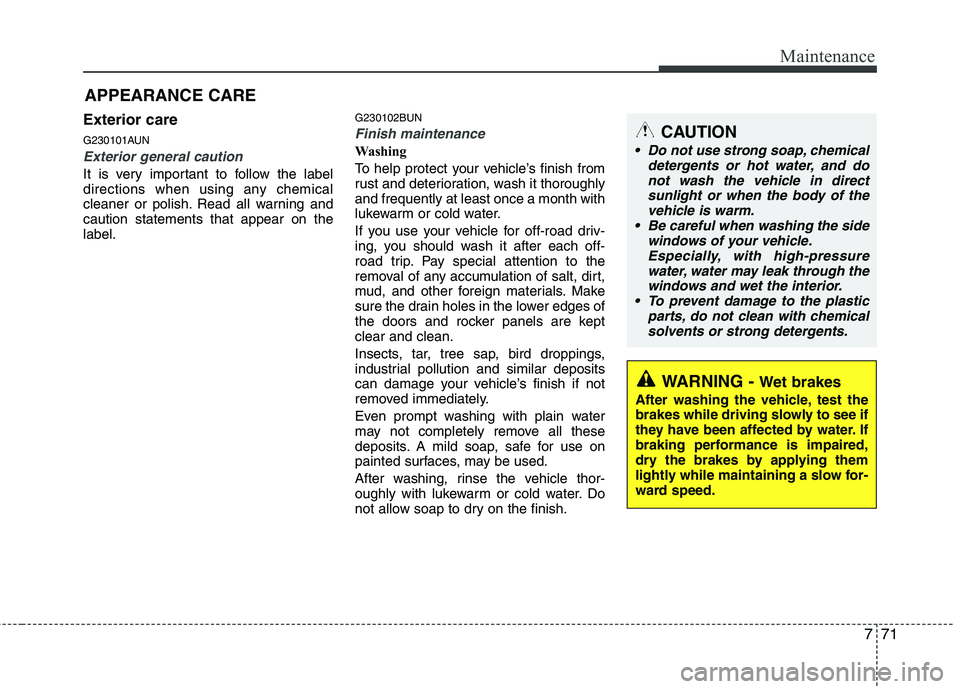Page 318 of 354

Maintenance
56
7
Instrument panel fuse panel
Descrption Symbol Fuse rating Protected component
AUDIO B+
15A Audio, DCDC Convertor
LOOM LP
10A TACM, ETACM, Door Warning Switch, Data Link Connector, Luggage Lamp, Room Lamp
Switch, Rear Fog Lamp Switch, Heater Control Module, Digital Clock, Instrument Cluster,
Overhead Console Lamp
P/WDW LH
25A Rear Power Window Switch LH, Power Window Main Switch,
Passenger Power Window Switch
P/WDW RH
25A Rear Power Window Switch RH, Power Window Main Switch,
Passenger Power Window Switch
TAIL LP LH
10A Head Lamp LH, DRL Control Module, License Lamp, Rear Combination Lamp LH
TAIL LP RH
10A Head Lamp RH, License Lamp, Rear Combination Lamp RH, Hazard Switch, Rheostat,
Instrument Cluster, Intake Switch, Rear Fog Lamp Switch,
DRL Control Module, Blower Switch, Heater Control Module, Head Lamp Leveling Device
Switch, Audio, Power Window Main Switch, Front Fog Lamp Switch, A/C Switch, Digital
Clock, Rear Defogger Switch, ISG Switch, ATM Shift Lever, Passenger Seat Warmer
Switch, Diode1/2, Driver Seat Warmer Switch, Rear Fog Lamp Switch, Buzzer, Rear
Defogger Relay
D/LOCK&S/ROOF
25A ICM RELAY BOX (Door Lock/Unlock Relay), Sunroof Motor, Driver Lock Actuator, ETACM
HTD GLASS
30A Rear Defogger Relay
WIPER SIG
10A Front Wiper Motor, Multifunction Switch, ECM
ABS
10A Stop Lamp Switch, ESP Switch, EPS Control Module,
ABS Control Module, Multipurpose Check Connector
T/SIG LP
10A Hazard Switch
Page 321 of 354
759
Maintenance
Engine compartment main fuse panel (for 1.1L and 1.2L)Symbol Fuse rating Protected component
80A EPS Control Module
100A Alternator
50A I/P Fuse & Relay Box (FUSE : F7/F8)
40A I/P Fuse & Relay Box (Power Window Relay)
40A ABS Control Module, ESP Control Module, Multipurpose Check Connector
40A ABS Control Module, ESP Control Module
40A RLY.6 (Blower Relay)
50A Ignition Switch
40A Ignition Switch
50AE/R Fuse & Relay Box (FUSE : F18, RLY : 7), I/P Fuse & Relay Box (POWER CONNECTOR : F1/F2, FUSE : F29/F30/F31/F32 )
30A E/R Fuse & Relay Box (FUSE : F15, RLY : R1)
40A E/R Fuse & Relay Box (RLY : R8)
15A E/R Fuse & Relay Box (RLY : R2)
10A Heater ControL Module, A/C Switch
10A PCM
Page 323 of 354
761
Maintenance
Engine compartment main fuse panel (for 1.0L)Symbol Fuse rating Protected component
80A EPS Control Module
100A Alternator
50A I/P Fuse & Relay Box (FUSE : F7/F8)
40A I/P Fuse & Relay Box (Power Window Relay)
40A ABS Control Module, ESP Control Module, Multipurpose Check Connector
40A ABS Control Module, ESP Control Module
40A RLY.6 (Blower Relay)
50A Ignition Switch
40A Ignition Switch
50AE/R Fuse & Relay Box (FUSE : F18, RLY : 7), I/P Fuse & Relay Box (POWER CONNECTOR : F1/F2,
FUSE : F29/F30/F31/F32 )
30A E/R Fuse & Relay Box (FUSE : F15, RLY : R1)
40A E/R Fuse & Relay Box (RLY : R8)
Page 325 of 354

763
Maintenance
LIGHT BULBS
G220000AEN
Use only the bulbs of the specified wattage.
✽✽ NOTICE
After heavy, driving rain or washing,
headlight and taillight lenses could
appear frosty. This condition is caused by
the temperature difference between the
lamp inside and outside. This is similar
to the condensation on your windows
inside your vehicle during the rain and
doesn’t indicate a problem with your
vehicle. If the water leaks into the lamp
bulb circuitry, have the vehicle checked
by an authorized HYUNDAI dealer.
G220100AUN
Headlight, position light, turn sig-
nal light, front fog light bulbreplacement
(1) Headlight (High/Low)
(2) Position light
(3) Front turn signal light
WARNING - Working on
the lights
Prior to working on the light, firmly
apply the parking brake, ensure
that the ignition switch is turned tothe LOCK position and turn off the
lights to avoid sudden movement
of the vehicle and burning your fin-
gers or receiving an electric shock.
CAUTION
Be sure to replace the burned-out bulb with one of the same wattage
rating. Otherwise, it may cause damage to the fuse or electricwiring system.
CAUTION
If you don’t have necessary tools,the correct bulbs and the expertise,
consult an authorized HYUNDAIdealer. In many cases, it is difficultto replace vehicle light bulbs because other parts of the vehicle
must be removed before you canget to the bulb. This is especiallytrue if you have to remove the head-
light assembly to
get to the bulb(s).
Removing/installingthe headlight
assembly can result in damage to the vehicle.OPA071033
Page 333 of 354

771
Maintenance
Exterior care
G230101AUN
Exterior general caution
It is very important to follow the label
directions when using any chemical
cleaner or polish. Read all warning andcaution statements that appear on thelabel.G230102BUN
Finish maintenance
Washing
To help protect your vehicle’s finish from
rust and deterioration, wash it thoroughlyand frequently at least once a month with
lukewarm or cold water.
If you use your vehicle for off-road driv-
ing, you should wash it after each off-
road trip. Pay special attention to the
removal of any accumulation of salt, dirt,
mud, and other foreign materials. Make
sure the drain holes in the lower edges of
the doors and rocker panels are keptclear and clean.
Insects, tar, tree sap, bird droppings,
industrial pollution and similar deposits
can damage your vehicle’s finish if not
removed immediately.
Even prompt washing with plain water
may not completely remove all these
deposits. A mild soap, safe for use on
painted surfaces, may be used.
After washing, rinse the vehicle thor-
oughly with lukewarm or cold water. Do
not allow soap to dry on the finish.
APPEARANCE CARE
CAUTION
Do not use strong soap, chemical
detergents or hot water, and do
not wash the vehicle in direct sunlight or when the body of thevehicle is warm.
Be careful when washing the side
windows of your vehicle.Especially, with high-pressure water, water may leak through the
windows and wet the interior.
To prevent damage to the plastic parts, do not clean with chemicalsolvents or strong detergents.
WARNING - Wet brakes
After washing the vehicle, test the
brakes while driving slowly to see if
they have been affected by water. If
braking performance is impaired,
dry the brakes by applying them
lightly while maintaining a slow for-
ward speed.
Page 340 of 354

Maintenance
78
7
EMISSION CONTROL SYSTEM (IF EQUIPPED)
G270000AEN
The emission control system of your
vehicle is covered by a written limited
warranty. Please see the warranty infor-
mation contained in the Service Passport
in your vehicle.
Your vehicle is equipped with an emis-
sion control system to meet all applicable
emission regulations. There are three emission control sys-
tems, as follows.
(1) Crankcase emission control system
(2) Evaporative emission control system(3) Exhaust emission control system In order to assure the proper function of
the emission control systems, it is rec-
ommended that you have your car
inspected and maintained by an author-
ized HYUNDAI dealer in accordance with
the maintenance schedule in this manu-al. Caution for the Inspection and
Maintenance Test (With Electronic
Stability Program (ESP) system)
To prevent the vehicle from misfir-
ing during dynamometer testing,
turn the Electronic Stability
Program (ESP) system off by press-
ing the ESP switch.
After dynamometer testing is com- pleted, turn the ESP system back on
by pressing the ESP switch again. G270100AUN
1. Crankcase emission control
system
The positive crankcase ventilation sys-
tem is employed to prevent air pollution
caused by blow-by gases being emitted
from the crankcase. This system supplies
fresh filtered air to the crankcase through
the air intake hose. Inside the crankcase,
the fresh air mixes with blow-by gases,
which then pass through the PCV valveinto the induction system.
G270200AUN
2. Evaporative emission control system
The Evaporative Emission Control
System is designed to prevent fuel
vapors from escaping into the atmos-
phere.
Page 350 of 354

95
Specifications
I040100BUN Recommended SAE viscosity
number Engine oil viscosity (thickness) has an
effect on fuel economy and cold weather
operating (engine start and engine oil
flowability). Lower viscosity engine oils
can provide better fuel economy and cold
weather performance, however, higher
viscosity engine oils are required for sat-
isfactory lubrication in hot weather. Using
oils of any viscosity other than those rec-ommended could result in engine dam-
age.When choosing an oil, consider the
range of temperature your vehicle will be
operated in before the next oil change.Proceed to select the recommended oil
viscosity from the chart.
CAUTION
Always be sure to clean the area
around any filler plug, drain plug, or
dipstick before checking or drain-ing any lubricant. This is especiallyimportant in dusty or sandy areas
and when the vehicle is used on unpaved roads. Cleaning the plugand dipstick areas will prevent dirt and grit from entering the engine and other mechanisms that could
be damaged.
Temperature Range for SAE Viscosity Numbers
Temperature
For Europe and
Middle East * 1
°C
(°F)-30 -20 -10 0 10 20 30 40 50 -10 0 20 40 60 80 100 120
*1. For better fuel economy, it is recommended to use the engine oil of a viscosity grade SAE0W-40, 5W-30, 5W-40 (API Service SL or above, ACEA A3 or above).
*2. For better fuel economy, it is recommended to use the engine oil of a viscosity grade SAE 5W-20,5W-30 (API SL or above/ILSAC GF-3 or above). However, if the engine oil is not avail-
able in your country, select the proper engine oil using the engine oil viscosity chart.
0W-40, 5W-30, 5W-40
Except Europe and
Middle East * 2
20W-50
10W-30
15W-40
5W-20, 5W-30